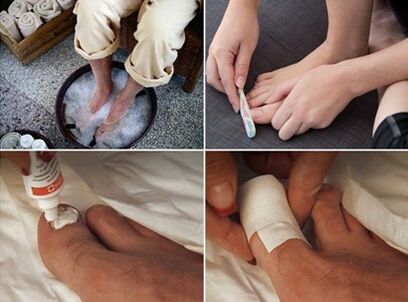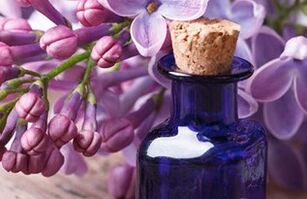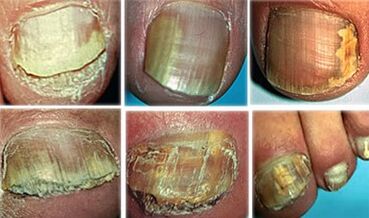Onychomycosis is a disease in which a fungal infection affects the surface of the nail plate. There are 3 types of pathogens that are most frequently detected in the analyzes: yeast-like fungi, molds, dermatophytes.
Why does the fungus occur?
The fungus itself cannot occur. The disease is always preceded by certain pressing factors, such asB. :
- Use of household items with fungal spores. If a family member has onychomycosis and others are using their towel, slippers, or socks, the risk of infection is quite high.
- Visiting public places with a large flow of people. Saunas, baths, swimming pools, solariums, showers, fitness clubs, beaches - all these places can become places of infection with onychomycosis.
- Shoes with constant high temperature and humidity. Fungal infection often overtakes office workers and military personnel who are forced to spend all day in shoes. Lack of air, compressed space and uncomfortable shoe models lead to increased sweating, blood congestion and thus to onychomycosis.
- Reduced immunity. If the immune system is weakened by the disease, onychomycosis can occur after taking antibiotics and other reasons.
- Age of the person. In children, the fungus does not appear due to physiological properties - the infectious pathogen needs a certain time to gain a foothold and multiply. And children's nails grow very quickly, so onychomycosis does not have time to develop. It often affects adults and almost always the elderly and the elderly. Your nail plates grow very slowly, making it especially difficult to remove the fungus on senile nails.
How can one understand that nails are affected by mycosis?
If the nail plate changes in any way, it indicates possible problems. Signs of onychomycosis are the following conditions:
- cracks between the fingers;
- yellowing of the nail plate;
- thickening of the skin;
- Separation of the nail without mechanical reasons;
- Burning and itching;
- inflamed nail folds;
- Thinning or thickening of the nail.
A healthy nail should be pink, shiny and smooth.
Fast and effective methods of treating fungi at home
The fight against onychomycosis usually takes at least a month. The sooner you start treatment, the sooner you will get rid of the disease. You can turn to traditional medicine or use pharmaceutical preparations. But it is better to combine proven advice and effective drugs so that you can quickly forget about the fungus.
Preparing the nail plate for treatment
Often, simply using antifungal agents does not lead to the desired result. This happens because medicinal substances cannot penetrate through the nail that has been thickened by the fungus.
Before starting treatment, the nail plate affected by onychomycosis should be removed. There are several ways to do this:
- Steam your feet in hot water. It is important to keep the water temperature fairly high (up to 50 degrees) for about half an hour. To do this, you can pour dry mustard into the water, constantly adding new servings of hot liquid. Next, you need to cut off the overgrown part of the steamed nail plate and reduce the thickness of the nail itself with a file of low abrasiveness (100-150 grit).
- Buy antifungal cream paste in the pharmacy. This tool comes from the budget segment, but can replace surgical removal or the removal of laser nails. The paste contains urea, which softens the nail plate without pain or discomfort. Then it is cut off or removed with a scraper. The drug is applied to clean and dry nails affected by onychomycosis, and a band-aid is stuck across it. It is important that you don't remove it for about 2 days. Several such procedures may be required at an advanced stage of the fungus.
- Use an antifungal cream. The main component is urea or urea. On muted, but towel-dried nails, you need to apply cream, seal with a plaster and do not remove for 3-4 days. Then again do a hot bath, remove the softened fragments.

Without removing the nail or its fragment affected by onychomycosis, there is no point in being treated.
Steam baths
High temperatures and water soften the nail plate. It becomes easier to deal with and remove diseased fragments if necessary. Before any medical procedure, you should give your legs plenty of steam. You can do this in the following ways:
- Stir 4 tablespoons of iodized salt, 200 g of baking soda and a few drops of lavender essential oil in hot water. Lower your legs and hold until it cools down. Then wash and dry with a clean towel.
- Finely grate a bar of tar soap. Put 3 tablespoons of the resulting "powder", a glass of baking soda, in a bowl of hot water and steam the legs for 10 to 20 minutes. It is good to use such a bath as a preparation before the next treatment procedure.
Cleaning products

If it is not possible to make a compress or apply an ointment for a long time, wiping off a painful nail will help. Onychomycosis requires constant and complex treatment, so sometimes you can use folk recipes:
- Soak a cotton ball in apple cider vinegar and generously lubricate sick nails. The fungus loves an alkaline environment, so its oxidation inhibits infection.
- Mix 2 tablespoons of marigold and lilac flowers, pour a glass of vodka and let it brew for at least a week. Apply to sore nails three times a day.
Wraps and compresses
Compresses have a good effect on the health of the nail and eliminate the infectious agent.
- Pour celandine on a cotton pad. Tighten the infected nail, bandage it lightly, put on socks and walk all day. After that, you can treat the plate with hydrogen peroxide or iodine.
- Rub a few cloves of garlic on a fine grater and add 1 teaspoon of vegetable oil. Apply the resulting gruel to the diseased nail plates, make a bandage on them and put on socks. Leave on for a few hours. If you get a burning sensation, remove the compress and wash your feet with tar soap.
Creams, pharmaceutical solutions
Antifungal drugs are effective against fungal infections. Often in the product line of a manufacturer there are both liquid product forms and different creams with the same active ingredient in the composition.
Tablets and capsules for oral administration
Treating a fungus is sometimes impossible without exposure to it "from the inside". Taking antifungal drugs will speed recovery.
Treatment of advanced toenail fungus

When you start onychomycosis, folk remedies become ineffective. In this case, you definitely need advice from a mycologist, or at least a dermatologist. Most likely he will prescribe the following procedures:
- Identifying the pathogen. Usually, a scrape is removed from the plate less often - a fragment of the nail. These materials are sent for microscopic examination.
- Taking medication. After determining the parasitic fungus, internal antifungal and topical preparations are prescribed.
- Removal of the affected part of the nail or the entire plate. If the onychomycosis affects less than half of its area, a medical pedicure is prescribed. If the entire nail plate has become infected, it may need to be surgically removed.
Methods of iodine treatment
The causative agent of onychomycosis feeds on keratin in the epidermis. The harmful effect of iodine on the fungus is that it holds this protein together and dies the infection. Repeated application of iodine to the affected area practically cauterizes the parasitic pathogen. The drug has an antiseptic effect that prevents the infection from developing again.
Iodine is an effective medicine. It can only be applied to the affected nail fragments. Contact with healthy skin can cause inflammation and severe burning.
In the advanced stage of onychomycosis, iodine as an additive in steam baths can help. Pour all of the preparation from the bottle into hot water and lower your legs for 20-30 minutes. A pronounced antiseptic effect is exerted not only on the nails, but also on the skin, where there may also be spores of the causative agent of the infection. After the procedure, you can treat your feet with hydrogen peroxide.
In the initial stage, you need to apply iodine to the nail plate with a cotton swab every few days. If after about a week the area under the affected area starts to burn, this is a good result, which indicates a successful treatment.
For a simultaneous antifungal and caring effect, you can add 3 drops of iodine to 2 tablespoons of olive oil. Heat this mixture in a water bath, apply it to sore nails and put on clean socks. Let stand overnight, wash your feet with soap and water in the morning.
Iodine is one of the cheapest drugs with high efficiency. Continuous use is possible throughout the month. If there are no results, you should change the type of therapy or consult a doctor.
Onychomycosis is successfully treated with complex local and systemic therapy. The combination of medicines and folk remedies allows you to defeat a fungal infection in a period of 1 month.































